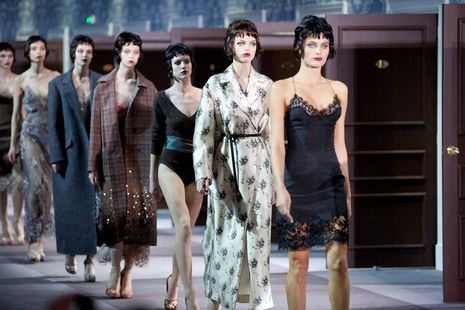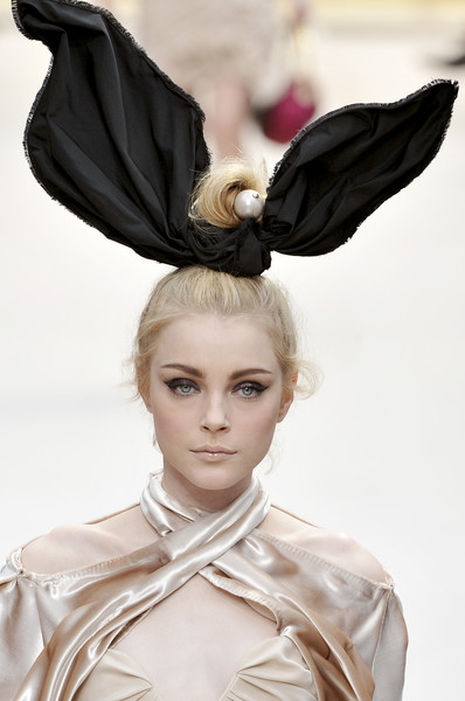The Influence of Sex Work on Fashion
Fashion Columnist Eva Morris looks to the pervasive yet hardly recognised influence of sex work on fashion design, investigating how the fashion industry has taken inspiration from sex workers’ styles for years

During almost every city-break holiday with my family, we can’t seem to help but wander into the red light district. With most of the city polished, ready for tourists to admire and shower in cash, the red light district can have an unfiltered ‘realness’ to it. In a society satiated with shame regarding sex work, its attempt to confine sex workers to seedy looking backstreets is undeniable. Yet such physical constraints eroticise the underworld of cities, encouraging the cultural appropriation of sex work in fashion design.
“Such a clumsy and ignorant attempt at story-telling crudely glamorised sex work for the upper echelons”
Marc Jacobs’ Autumn Winter 2013 collection for Louis Vuitton — in particular its video for Love magazine — is one of the most blatantly harmful examples of the fashion industry’s attitude towards the sex industry. In the video, Cara Delevingne, Georgia May Jagger, Isabeli Fontana and Edie Campbell are seen donning short brown bobs and wearing silk slips beneath fur coats which are seductively revealed for passing cars and the male gaze of the camera. Such a clumsy and ignorant attempt at story-telling crudely glamorised sex work for the upper echelons to eat up for entertainment.

The video received backlash, with Louis Vuitton distancing themselves from Marc Jacobs when he stepped down as creative director later that year. Popular opposition to the video staunchly critiqued it for allowing a man to remove women from a narrative centred around sex work, whilst objectifying them in the process. Despite uproar, this was not the first and would not be the last time that Louis Vuitton, Marc Jacobs and other designers took from the lives of sex workers to create something ‘chic’.
Looking back to Louis Vuitton’s Autumn Winter 2009 collection, we see a more subtle example of appropriated sex work in the depiction of models wearing sheer tops and fabric headbands resembling the iconic playboy bunny ears. Such a pattern continues with Marc Jacobs’ AW 2016 runway, featuring most models coming out in latex platform boots covered in buckles. Both the latex fabric and the high platform were reminiscent of the styles strippers often adopt, with platform shoes traced back to 16th century Venice, where they were exclusively worn by upper-class escorts. The imitation of sex work fashion by designers such as Louis Vuitton and Marc Jacobs has filtered through to the everyday, in the form of the thigh-high boots we all loved in the 2010s, and the current popularity of latex dresses or crop tops.
“Perhaps we can see a more subtle and fine tuned portrayal of fashion’s intricate link with the sex industry shown by someone who has lived it”
So why have none of these examples received similar backlash? There is a crucial difference between taking inspiration from the styles of the sex work community and taking the narrative from them. In the infamous Love magazine video, the sex worker community had their agency stripped away, with no say in the script, the performance or the direction. The video was a tacky wet dream of what sex work actually is.
Designers on the runway have simply taken their styles for profit without any reference back to the original inspiration, and the damage caused is subtle enough that many carry on without questioning such appropriation. The male gaze is omnipresent, dictating what we normalise as acceptable in fashion and the everyday. This appropriation is far harder to spot in a society so hesitant to recognise any form of culture behind the sex industry beyond the fetishised and frivolous.
So what do we do now... burn our platform boots and say goodbye to the days of wearing tight dresses? What we need are new voices to give life to fashionable narrations of sub-cultures, rather than the removing and appropriating of sex work. Just as it is important to acknowledge all sub-cultures within our city, we must understand and acknowledge how they are manifested within our wardrobes.
The prominence of sex industry inspired styles in fashion can take a turn. With celebrities, like Cardi B and Megan Barton-Hanson, who previously worked in the sex industry coming into the public eye, there is potential for the voice of sex workers to emerge in fashion. Perhaps we can see a more subtle and fine tuned portrayal of fashion’s intricate link with the sex industry shown by someone who has lived it, rather than a knock-off by a privileged observer. The influence the sex industry has on fashion should not be hidden away nor imitated by those who haven’t taken the time to understand it, but should be celebrated by those who’ve lived every part of it. What we truly need is the dawn of a new era of dressing.
 News / Local business in trademark battle with Uni over use of ‘Cambridge’17 January 2026
News / Local business in trademark battle with Uni over use of ‘Cambridge’17 January 2026 News / Cambridge bus strikes continue into new year16 January 2026
News / Cambridge bus strikes continue into new year16 January 2026 Comment / Fine, you’re more stressed than I am – you win?18 January 2026
Comment / Fine, you’re more stressed than I am – you win?18 January 2026 News / News in Brief: cosmic connections, celebrity chefs, and ice-cold competition18 January 2026
News / News in Brief: cosmic connections, celebrity chefs, and ice-cold competition18 January 2026 Film & TV / Anticipating Christopher Nolan’s The Odyssey17 January 2026
Film & TV / Anticipating Christopher Nolan’s The Odyssey17 January 2026










